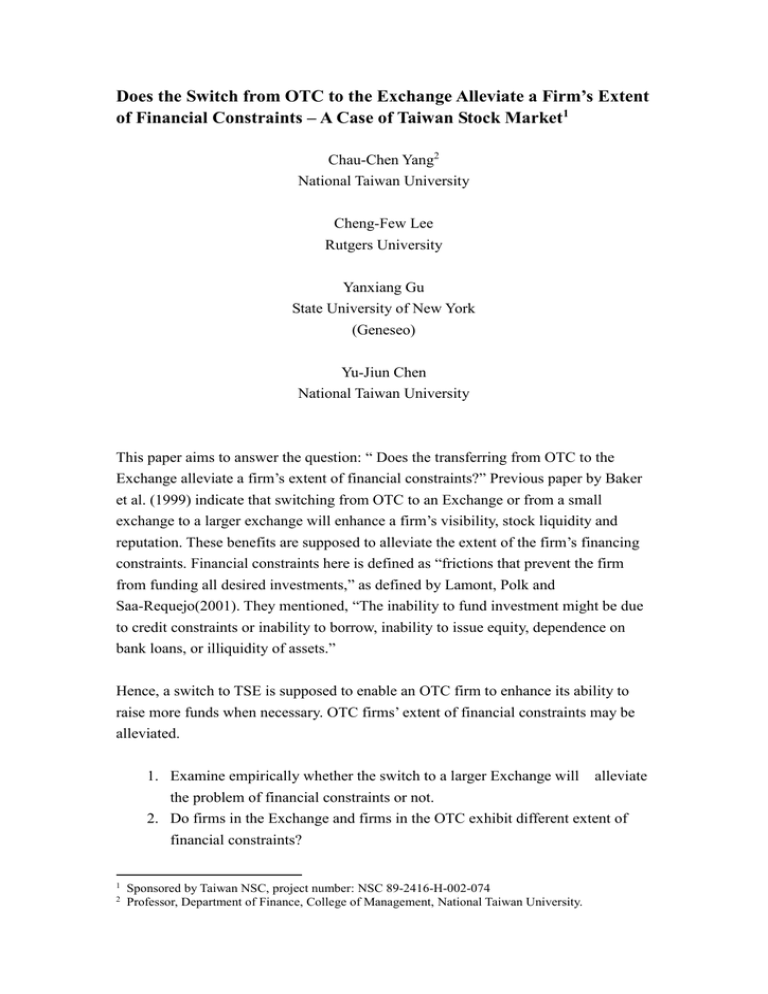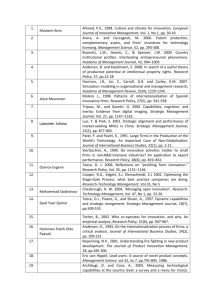Does the Switch from OTC to the Exchange Alleviate a Firm’s Extent of Financial Constraints—A Case of
advertisement

Does the Switch from OTC to the Exchange Alleviate a Firm’s Extent of Financial Constraints – A Case of Taiwan Stock Market1 Chau-Chen Yang2 National Taiwan University Cheng-Few Lee Rutgers University Yanxiang Gu State University of New York (Geneseo) Yu-Jiun Chen National Taiwan University This paper aims to answer the question: “ Does the transferring from OTC to the Exchange alleviate a firm’s extent of financial constraints?” Previous paper by Baker et al. (1999) indicate that switching from OTC to an Exchange or from a small exchange to a larger exchange will enhance a firm’s visibility, stock liquidity and reputation. These benefits are supposed to alleviate the extent of the firm’s financing constraints. Financial constraints here is defined as “frictions that prevent the firm from funding all desired investments,” as defined by Lamont, Polk and Saa-Requejo(2001). They mentioned, “The inability to fund investment might be due to credit constraints or inability to borrow, inability to issue equity, dependence on bank loans, or illiquidity of assets.” Hence, a switch to TSE is supposed to enable an OTC firm to enhance its ability to raise more funds when necessary. OTC firms’ extent of financial constraints may be alleviated. 1. Examine empirically whether the switch to a larger Exchange will alleviate the problem of financial constraints or not. 2. Do firms in the Exchange and firms in the OTC exhibit different extent of financial constraints? 1 2 Sponsored by Taiwan NSC, project number: NSC 89-2416-H-002-074 Professor, Department of Finance, College of Management, National Taiwan University. 3. Do switchers and stayers exhibit similar degree of financial constraints? I. Introduction to Taiwan’s Stock Markets Table 1 Statistics of Stocks Listed in TSE Unit:NT$1,000,000. Newly Listed No. Amount 40,122 Delisting No. End of Year Amount 1991 24 1992 36 34,958 1993 29 45,796 1994 31 51,533 3 1995 41 50,838 1996 36 1997 No. Amount 2 2,221 221 643,086 1 175 256 761,091 285 908,373 2,220 313 1,099,071 7 2,270 347 1,346,679 82,543 1 6,418 382 1,661,270 26 78,889 4 8,380 404 2,106,285 1998 35 171,026 2 437 2,734,075 1999 33 82,578 8 33,378 462 3,803,017 2000 80 207,220 11 43,686 531 3,661,357 2001 69 363,434 16 251,070 584 4,099,920 2002 85 413,911 31 459,002 638 4,443,007 2003 46 174,956 14 117,899 670 4,721,605 2004 38 150,381 10 69,180 698 5,058,080 *Data source: Securities and Futures Monthly (Taiwan), Vol.23, No.1, 2005. Table 2 Statistics of Stocks Listed in OTC Unit:NT$1,000,000. Newly Listed No. Amount Delisting End of Year Switching Delisted Total to TSE 1991 5 1,572 1992 3 778 1 0 1 1993 3 715 3 0 3 1994 3 5,520 1995 29 162,283 1996 38 73,497 1997 41 38,618 3 3 6 1998 74 99,116 7 5 1999 102 130,434 13 2000 105 160,124 97 Amount No. Amount 9 3,777 670 11 4,470 1,781 11 3,958 14 9,793 41 173,005 79 264,133 38,096 114 314,886 12 106,727 176 381,391 1 14 52,084 264 513,759 61 8 69 85,369 300 676,245 96,668 48 16 64 170,404 333 681,336 2002 110 77,991 44 15 59 193,259 384 627,293 2003 83 48,281 24 20 44 83,573 423 639,472 2004 87 50,447 26 18 44 123,544 466 626,097 2001 2 0 2 1,275 *Data source: Securities and Futures Monthly (Taiwan), Vol.23, No.1, 2005. As shown in Table 1 and Table 2, at the end of 2004, there are 466 and 698 listed firms in the OTC and TSE respectively in Taiwan. Of the newly listed firms in TSE during the period from 1991 to 2004, 232 firms are transferred from the OTC. Table 3 summarizes the allocation of industries of these switchers. The transferring reached its peak in 2000 when the High-tech bubbles blew up worldwide. Figure 1 shows the comparison between the number of transferring and the TSE stock index. Table 3 Allocation of Industries of Switchers. Figure 1 Comparison between the number of transferring and the TSE stock index. II. Literature on Listing Changes and Financing Constraints A. Listing Changes Why do firms change listing? Relevant literatures indicate that there are multiple reasons that may account for firms’ switching from the OTC to the exchange, or from a smaller exchange to a larger exchange.. B. Financing Constraints III. Research Methodology A. Data Financial data are obtained from TEJ (Taiwan Economic Journal) from 1991 to 2003. Banking, insurance and security firms are excluded from the sample. B. Hypothesis C. Financial Models 1.To investigate whether the switching of listing has an impact on the capital investments and the degree of financial constraints of listed firms in Taiwan? A slope dummy regression approach will be used to examine the difference of the regression coefficients before and after the dividend imputation. ( I )it ai biQit ci D Qit eit K I CF CF )it ai biQit ci D Qit d i ( )it ei D ( )it eit K K K WC CF ( )it ai bQit c( )it eit K K ( ( WC CF CF )it ai bQit ci D Qit d i ( )it ei D ( )it eit K K K (2) Whether the results in (1) will be different for the OTC firms and the TSE firms? D. Econometric Model IV. Empirical Results V. Conclusions References Baker, Kent H., Gary E. Powell and Daniel G. Weaver, Does NYSE Listing Affect Firm Visibility? Financial Management; Summer 1999; 28, 2; pp. 46-54. Baker, Kent H., Gary E. Powell and Daniel G. Weaver, Listing Changes and Visibility Gains, Quarterly Journal of Business and Economics; Winter 1999; 38, 1. pp. 46-63. Baker, Kent H. and Richard B. Edelman, The Effects on Spread and Volume of Switching to the Nasdaq National Market System, Financial Analyst Journal; Jan/Feb 1992; 48, 1; pp. 83-88. Baker, Kent H. and Richard B. Edelman, AMEX-to-NYSE Transfers, Market Microstructure, and Shareholder Wealth, Financial Management; Winter 1992; 21, 4; pp. 60-72. Black, Ervin L., Joseph Legoria, and Keith F. Sellers, Capital Investment Effects of Dividend Imputation. The Journal of the American Taxation association, Fall 2000, Vol. 22, No. 2, 40-59. Blose, Laurence E. and Joseph C.P. Shieh, 1997, Tobin’s q-ratio and market reaction to capital investment announcements, The Financial Review Vol. 32 No. 3, 449-476 Brainard, William C. and James Tobin, 1968, Pitfalls in financial model building, American Economic Review 58, 99-122 Calem, Paul S. and John A. Rizzo, 1995, Financing constraints and investment: new evidence from hospital industry data, Journal of Money, Credit and Banking Vol. 27 No. 4, 1002-1014. Calomiris, Charles W. and Glenn Hubbard, Internal Finance and Investment: Evidence from the Undistributed Profits Tax of 1936-37. The Journal of Business, Vol. 68, No. 4 (Oct., 1995), 443-482. Dharan, Bala G. and David L. Ikenberry, The Long-Run Negative Drift of Post-Listing Stock Returns, The Journal of Finance, Vol. 50, No. 5(Dec, 1995), pp. 1547-1574. Devereux, Michael, Fabio Schiantarelli, 1989, Investment, financial factors and cash flow: evidence from UK panel data, NBER working paper No. 3116 Faroque, Akheter and T. Ton-That, 1995, Financing constraints and firm heterogeneity in investment behavior: and application of non-nested tests, Applied ECONOMICS 27, 317-326 Fazzari, Steven M., R. Glen Hubbard, Bruce C. Petersen, 1996, Asymmetric information, financing constraints and investment, Review of Economics and Statistics Vol. 69 No. 3, 481-488 Fazzari, Steven M, R. Glenn Hubbard, Bruce C. Petersen, 1996, Financing constraints and corporate investment: response to Kaplan and Zingales, NBER working paper No. 5462 Fazzari, Steven M., R. Gleen Hubard, Bruce C. Petersen, 1988, Financing constraints Brookings Papers on Economic Activity, 141-206 Galeotti, Marzio, Fabio Schiantarelli and Fidel Jaramillo, 1994, Investment decisions and the role of debt, liquid assets and cash flow: evidence from Italian panel data, Applied Financial Economics 4, 121-132 Gilchrist, Simon, Charles P. Himmelberg, 1995, Evidence on the role of cash flow for investment, Journal of Monerary Economics 36, 541-572 Green, W. H. 1992, Limdep-user’s manual and reference guide, New York: Econometric Software, Inc. Hayshi Fumio, 1982, Tobin’s marginal q and average q: A neoclassical interpretation, Econometrica Vol. 50 No. 1, 213-224 Hoshi, Takeo, Anil Kashyap, David Scharfstein, 1991, Corporate structure, liquiity and investment: evidence from Japanese industrial groups, Quarterly Journal of Economics 106, 33-60 Jahera, John, William Lloyd, and Naval Modani, 1986, Growth, beta and agency costs as determinants of dividend, Akron Business and Economic Review, Vol; 17, 55-69 Jose, Manual L., Len M. Nichols and Jerry L. Stevens, 1986, Contributions of diversification promotion and R&D tot he value of multiproduct firms: a Tobin’s q approach, Financial Management 15, 33-42 Kaplan, Steven N. and Luigi Zingales, 1995, Do financing constraints explain why investment is correlated with cash flow?, Working Paper No. 5267, National Bureau of Economic Research Kaplan, Stenev N. and Luigi Zingales, 1997, Do investment-cash flow sensitivities provide useful measures of financing constraints?, Quarterly Journal of Economics 1, 169-215 Lamont, Owen, 1997, Cash flow and investment: evidence from internal capital markets, Journal of Finance Vol. LII NO. 1, 83-109 Lang, Larry, Eli Ofek and Rene M. Stulz, 1996, Leverage, investment and firm growth, Journal of Financial Economics 40, 3-29 Lee, Bong-Soo, Tom Nohel, 1997, Value maximization and the information content of corporate investment with respect to earnings, Journal of Banking and Financing 21, 661-683 Lewellen, Wibur G., S. G. Badrinah, 1997, On the measurement of Tobin’s q, Journal of Financial Economics 44, 77-122 Lindenberg, Eric B. and Stephen A. Ross, Tobin’s q ratio and industrial organization, Journal of Business 54, 1-32 Lintner J., 1956, Distribution of incomes of corporations among dividends retained earnings and taxed, American Economic Review Miller, Merton and Franco Modigliani, 1961, Dividend policy, growth and the valuation of shares, Journal of Business Modigliani, Franco and Merton Miller, 1958, The cost of capital, corporation finance and the theory of investment, American Economic Review 8, 261-297 Myers, Stewart C. and Nicholas S. Majluf, 1984, Corporate Financing decisions when firms have investment information the investors do not, Journal of Financial Economics 13, 187-221 Partington, Garaham H., 1987, Variables influencing dividend policy in Australia: Survey results, Journal of Business Finance and Accounting, Vol. 16, 165-182 Ramirez, Carlos D., 1995, Did J. P. Morgan’s men add liquidity? Corporate investment, cash flow ad financial structure at the turn o the twentieth century, Journal of Finance Vol. L No. 2, 661-678 Roseff, Michael S., 1982, Growth, beta, and agency cost as determinants of dividend payout ratios, Journal of Financial Research, Vol. 5, 249-259 Schaller, Huntley, 1993, Asymmetric information, liquidity constraints and Canadian investment, Canadian Journal of Economics 26, No. 3, 552-574 Stiglitz, Joseph and Andrew Weiss, 1981, Credit rationing in markets with imperfect information, American Economic Review 71, 393-401 Tinbergen, Jan., 1939, A method and its application to investment activity, In Statistical Testing of Business Cycle Theories Vol. 1 Tobin, James, 1969, A general equilibrium approach to monetary theory, Journal of Money, Credit and Banking 1, 15-29 Whited, Toni M. 1992, Debt, liquidity constraints and corporate investment: evidence from panel data, Journal of Finance Vol. XL, VII, 1425-1460 Yang, Lin and Lu, “Investment Strategy, Dividend Policy and Financial Constraints of the Firm,” Review of Pacific Basin Financial Markets and Policies; 2000; vol. 3, no. 2, pp. 235-267.





